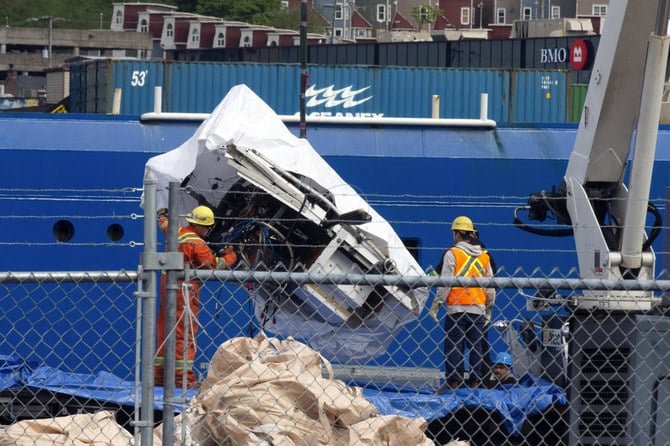The Titan submersible’s debris has been returned to land after a deadly implosion during its mission to the Titanic’s wreckage captivated the world’s attention last week.
The return of the wreckage to St. John’s, Newfoundland and Labrador, is an important part of the inquiry into why the submersible collapsed, killing all five personnel on board. On Wednesday, twisted pieces of the 22-foot submersible were unloaded at a Canadian Coast Guard pier.
Horizon Arctic, a Canadian ship, carried a remotely operated vehicle, or ROV, to search the ocean floor near the Titanic catastrophe for submersible fragments. Pelagic Research Services, which owns the ROV and has offices in Massachusetts and New York, announced on Wednesday that it had finished offshore operations.
According to Jeff Mahoney, a spokeswoman for Pelagic Research Services, the company’s staff is “still on mission” and cannot comment on the current Titan investigation, which involves various government organizations in the United States and Canada.
“They have been working around the clock now for ten days, through the physical and mental challenges of this operation, and are anxious to finish the mission and return to their loved ones,” Mahoney said.
The Coast Guard stated last week that debris from the Titanic was found around 12,500 feet (3,810 meters) deep and about 1,600 feet (488 meters) from the Titanic on the ocean floor. The Coast Guard is in charge of the inquiry into why the submersible imploded during its descent on June 18. On June 22, officials stated that the submersible had imploded, killing all five individuals on board.
The Coast Guard has established a Marine Board of Investigation to investigate the implosion. The Coast Guard conducts the highest level of investigation.
According to one of the experts engaged by the Coast Guard during the hunt, studying the physical substance of retrieved debris could offer crucial clues about what happened to the Titan. There may also be electronic data, according to Carl Hartsfield of the Woods Hole Oceanographic Institution.
“Certainly all the instruments on any deep sea vehicle, they record data. They pass up data. So the question is, is there any data available? And I really don’t know the answer to that question,” he said Monday.
Representatives for Horizon Arctic did not respond to requests for comment.On Wednesday, Coast Guard representatives declined to comment on the inquiry or the return of trash to shore. Although no bodies have been recovered, Coast Guard authorities have stated that they are taking precautions in case they come across human remains throughout the inquiry.
Stockton Rush, the CEO and pilot of Ocean Gate, died in the implosion, as with two members of a renowned Pakistani family, Shahzada Dawood and his son Suleman Dawood; British adventurer Hamish Harding; and Titanic historian Paul-Henri Nargeolet.
The National Transportation Safety Board and the Transportation Safety Board of Canada, both of which are involved in the inquiry, declined to comment. According to the National Transportation Safety Board, the Coast Guard has deemed the Titan submersible’s loss a “major marine casualty” and will lead the inquiry.
“We are not able to provide any additional information at this time as the investigation is ongoing,” said Liam MacDonald, a spokesperson for the Transportation Safety Board of Canada.
According to a spokeswoman for the International Maritime Organization, the United Nations’ maritime body, any investigative reports from the incident would be submitted for consideration. Changes, like as stricter regulations for submersibles, can also be proposed by IMO member nations.
Currently, the IMO has voluntary safety criteria for tourist submersibles that include, among other things, the requirement that they be inspected, have emergency response procedures, and have a qualified pilot on board. The IMO is unlikely to discuss any safety improvements until the next Maritime Safety Committee convenes in May 2024.
The Titan was owned and operated by OceanGate Expeditions, which is based in the United States, although the submarine was registered in the Bahamas. When the Titan was discovered, the OceanGate firm in Everett, Washington, was forced to close. Meanwhile, the Polar Prince, the Titan’s mother ship, was from Canada.
The operator cost each passenger $250,000 to take part in the cruise. The Titan’s demise has prompted concerns about the safety of private undersea exploration operations. The Coast Guard also intends to use the research to improve submersible safety.






